国际商务英语课文电子版lesson (10)
- 格式:doc
- 大小:37.50 KB
- 文档页数:14


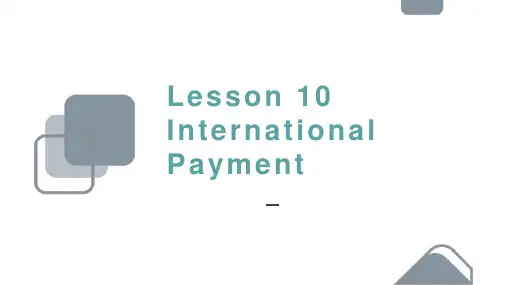

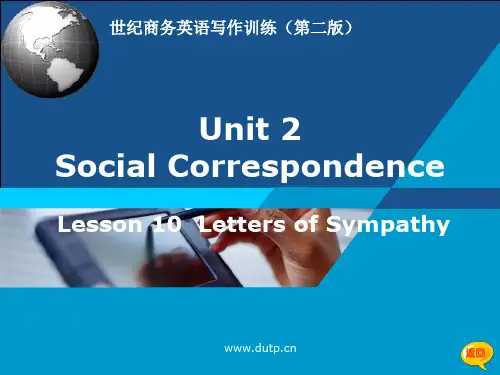
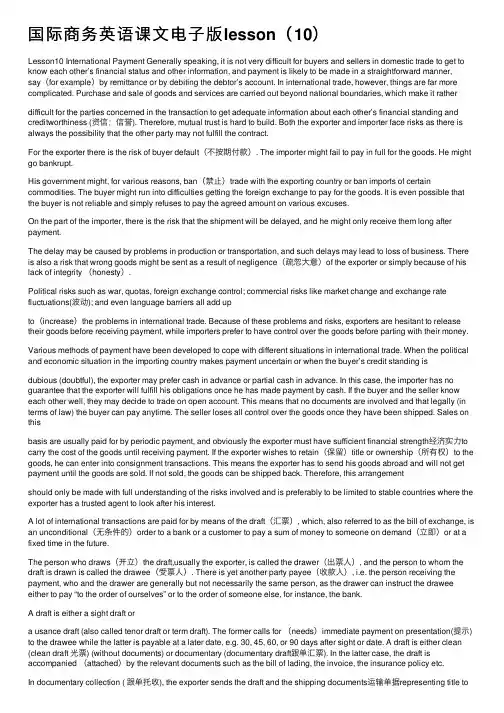
国际商务英语课⽂电⼦版lesson(10)Lesson10 International Payment Generally speaking, it is not very difficult for buyers and sellers in domestic trade to get to know each other’s financial status and other information, and payment is likely to be made in a straightforward manner,say(for example)by remittance or by debiting the debtor’s account. In international trade, however, things are far more complicated. Purchase and sale of goods and services are carried out beyond national boundaries, which make it ratherdifficult for the parties concerned in the transaction to get adequate information about each other’s financial standing and creditworthiness (资信;信誉). Therefore, mutual trust is hard to build. Both the exporter and importer face risks as there is always the possibility that the other party may not fulfill the contract.For the exporter there is the risk of buyer default(不按期付款). The importer might fail to pay in full for the goods. He might go bankrupt.His government might, for various reasons, ban(禁⽌)trade with the exporting country or ban imports of certain commodities. The buyer might run into difficulties getting the foreign exchange to pay for the goods. It is even possible that the buyer is not reliable and simply refuses to pay the agreed amount on various excuses.On the part of the importer, there is the risk that the shipment will be delayed, and he might only receive them long after payment.The delay may be caused by problems in production or transportation, and such delays may lead to loss of business. There is also a risk that wrong goods might be sent as a result of negligence(疏忽⼤意)of the exporter or simply because of his lack of integrity (honesty).Political risks such as war, quotas, foreign exchange control; commercial risks like market change and exchange rate fluctuations(波动); and even language barriers all add upto(increase)the problems in international trade. Because of these problems and risks, exporters are hesitant to release their goods before receiving payment, while importers prefer to have control over the goods before parting with their money. Various methods of payment have been developed to cope with different situations in international trade. When the political and economic situation in the importing country makes payment uncertain or when the buyer’s credit standing isdubious (doubtful), the exporter may prefer cash in advance or partial cash in advance. In this case, the importer has no guarantee that the exporter will fulfill his obligations once he has made payment by cash. If the buyer and the seller know each other well, they may decide to trade on open account. This means that no documents are involved and that legally (in terms of law) the buyer can pay anytime. The seller loses all control over the goods once they have been shipped. Sales on thisbasis are usually paid for by periodic payment, and obviously the exporter must have sufficient financial strength经济实⼒to carry the cost of the goods until receiving payment. If the exporter wishes to retain(保留)title or ownership(所有权)to the goods, he can enter into consignment transactions. This means the exporter has to send his goods abroad and will not get payment until the goods are sold. If not sold, the goods can be shipped back. Therefore, this arrangementshould only be made with full understanding of the risks involved and is preferably to be limited to stable countries where the exporter has a trusted agent to look after his interest.A lot of international transactions are paid for by means of the draft(汇票), which, also referred to as the bill of exchange, is an unconditional(⽆条件的)order to a bank or a customer to pay a sum of money to someone on demand(⽴即)or at a fixed time in the future.The person who draws(开⽴)the draft,usually the exporter, is called the drawer(出票⼈), and the person to whom the draft is drawn is called the drawee(受票⼈). There is yet another party payee(收款⼈), i.e. the person receiving the payment, who and the drawer are generally but not necessarily the same person, as the drawer can instruct the drawee either to pay “to the order of ourselves” or to the order of someone else, for instance, the bank.A draft is either a sight draft ora usance draft (also called tenor draft or term draft). The former calls for (needs)immediate payment on presentation(提⽰) to the drawee while the latter is payable at a later date, e.g. 30, 45, 60, or 90 days after sight or date. A draft is either clean (clean draft 光票) (without documents) or documentary (documentary draft跟单汇票). In the latter case, the draft is accompanied (attached)by the relevant documents such as the bill of lading, the invoice, the insurance policy etc.In documentary collection ( 跟单托收), the exporter sends the draft and the shipping documents运输单据representing title tothe goods to his bank, which forwards (sends)them to another bank in the importer’s country, which in turn contacts the customer (importer). In the case of documents against payment (D/P)付款交单, documents will not be released to the importer until payment is effected执⾏. There are D/P at sight and D/P after sight. The former requires immediate paymentby the importer to get hold of the documents. The latter gives the importer a certain period after presentation of the documents, but documents are not released to him until he actually pays for the merchandise货物. In the case of documents against acceptance (D/A)承兑交单, documents are handed over to the importer upon his acceptance(承兑)of the bill of exchange drawn by the exporter. Payment will not be made until a later date. D/A is always after sight.So far as the exporter’s interest is concerned, D/P at sight is more favorable than D/P after sight, and D/P is more favorable than D/A. In actual trade, payment by collection should be accepted with discretion (⼩⼼). It is usually used when the financial standing of the importer is sound(良好的), or when the exporter wishes to push the sale of his goods, or when the transaction involves only a small quantity. Otherwise, the letter of credit is generally preferred.。
![电子教案(PPT版本)]电子商务英语 (10)[14页]](https://uimg.taocdn.com/0999bee283c4bb4cf6ecd10c.webp)
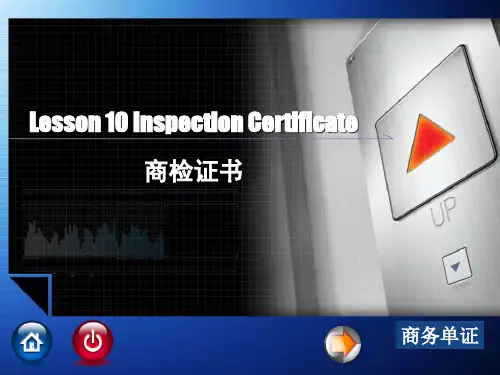

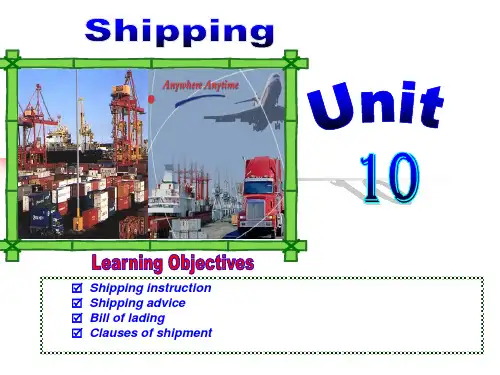
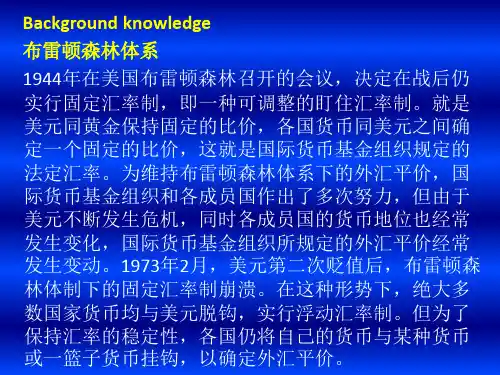
Lesson10 International Payment Generally speaking, it is not very difficult for buyers and sellers in domestic trade to get to know each other’s financial status and other information, and payment is likely to be made in a straightforward manner, say(for example)by remittance or by debiting the debtor’s account. In international trade, however, things are far more complicated. Purchase and sale of goods and services are carried out beyond national boundaries, which make it ratherdifficult for the parties concerned in the transaction to get adequate information about each other’s financial standing and creditworthiness (资信;信誉). Therefore, mutual trust is hard to build. Both the exporter and importer face risks as there is always thenot fulfill the contract.For the exporter there is the risk of buyer default(不按期付款). The importer might fail to pay in full for the goods. He might go bankrupt.His government might, for various reasons, ban(禁止)trade with the exporting country or ban imports of certain commodities. The buyer might run into difficulties getting the foreign exchange to pay for the goods. It is even possible that the buyer is not reliable and simply refuses to pay the agreed amount on various excuses.On the part of the importer, there is the risk that the shipment will be delayed, and he might only receive them long after payment.The delay may be caused by problems in production or transportation, and such delays may lead to loss of business. There is also a risk that wrong goods might be sent as a result of negligence(疏忽大意)of the exporter or simply because of his lack of integrity (honesty).Political risks such as war, quotas, foreign exchange control; commercial risks like market change and exchange rate fluctuations(波动); and even language barriers all add upto(increase)the problems in international trade. Because of these problems and risks, exporters are hesitant to release their goods before receiving payment, while importers prefer to have control over the goods before parting with their money.Various methods of payment have been developed to cope with different situations in international trade. When the political and economic situation in the importing country makes payment uncertain or when the buyer’s credit standing isdubious (doubtful), the exporter may prefer cash in advance or partial cash in advance. In this case, the importer has no guarantee that the exporter will fulfill his obligations once he has made payment by cash. If the buyer and the seller know each other well, they may decide to trade on open account. This means that no documents are involved and that legally (in terms of law) the buyer can pay anytime. The seller loses all control over the goods once they have been shipped. Sales on thisbasis are usually paid for by periodic payment, and obviously the exporter must have sufficient financial strength经济实力to carry the cost of the goods until receiving payment. If the exporter wishes to retain(保留)title or ownership(所有权)to the goods, he can enter into consignment transactions. This means the exporter has to send his goods abroad and will not get payment until the goods are sold. If not sold, the goods can be shipped back. Therefore, this arrangementshould only be made with full understanding of the risks involved and is preferably to be limited to stable countries where the exporter has a trusted agent to look after his interest.A lot of international transactions are paid for by means of the draft(汇票), which, also referred to as the bill of exchange, is an unconditional(无条件的)order to a bank or a customer to pay a sum of money to someone on demand(立即)or at a fixed time in the future.The person who draws(开立)the draft,usually the exporter, is called the drawer(出票人), and the person to whom the draft is drawn is called the drawee(受票人). There is yet another party payee(收款人), i.e. the person receiving the payment, who and the drawer are generally but not necessarily the same person, as the drawer can instruct the drawee either to pay “to the order of ourselves” or to the order of someone else, for instance, the bank.A draft is either a sight draft ora usance draft (also called tenor draft or term draft). The former calls for (needs)immediate payment on presentation(提示) to the drawee while the latter is payable at a later date, e.g. 30, 45, 60, or 90 days after sight or date. A draft is either clean (clean draft 光票) (without documents) or documentary (documentary draft跟单汇票). In the latter case, the draft is accompanied (attached)by the relevant documents such as the bill of lading, the invoice, the insurance policy etc.In documentary collection ( 跟单托收), the exporter sends the draft and the shipping documents运输单据representing title to the goods to his bank, which forwards (sends)them to another bank in the importer’s country, which in turn contacts the customer (importer). In the case of documents against payment (D/P)付款交单, documents will not be released to the importer until payment is effected执行. There are D/P at sight and D/P after sight. The former requires immediate paymentby the importer to get hold of the documents. The latter gives the importer a certain period after presentation of the documents, but documents are not released to him until he actually pays for the merchandise货物. In the case of documents against acceptance (D/A)承兑交单, documents are handed over to the importer upon his acceptance(承兑)of the bill of exchange drawn by the exporter. Payment will not be made until a later date. D/A is always after sight.So far as the exporter’s interest is concerned, D/P at sight is more favorable than D/P after sight, and D/P is more favorable than D/A. In actual trade, payment by collection should be accepted with discretion (小心). It is usually used when the financial standing of the importer is sound(良好的), or when the exporter wishes to push the sale of his goods, or when the transaction involves only a small quantity. Otherwise, the letter of credit is generally preferred.。